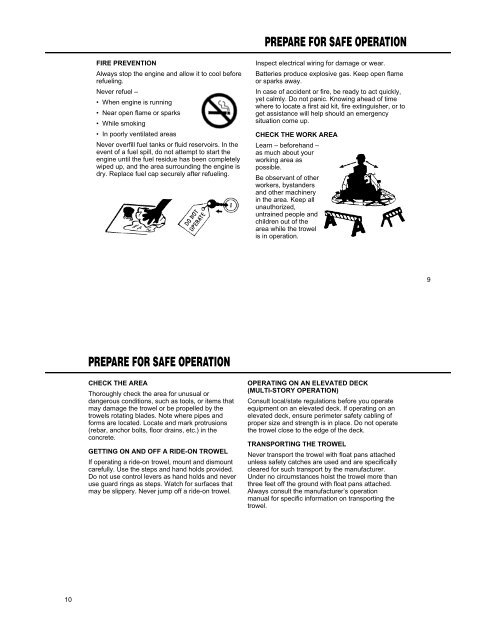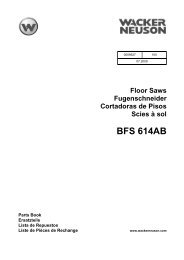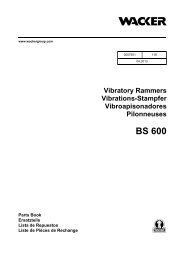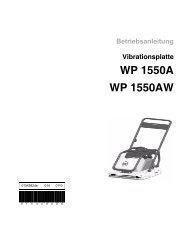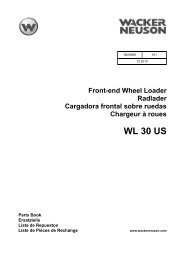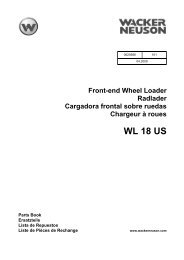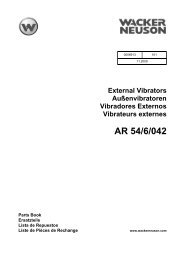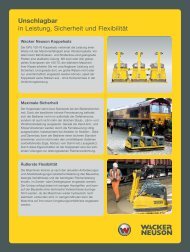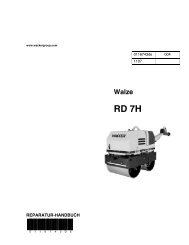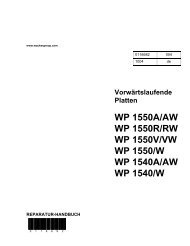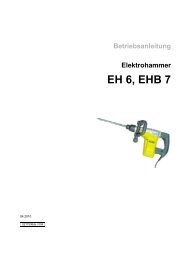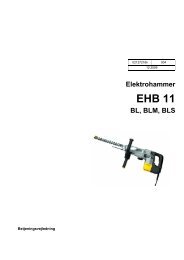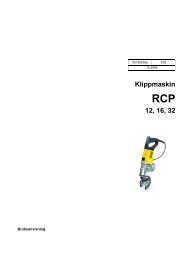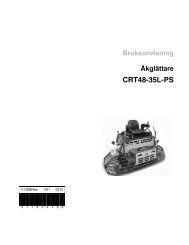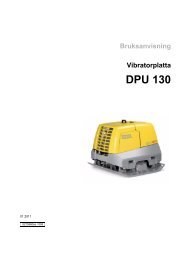CRT 48 Operation - Wacker Neuson
CRT 48 Operation - Wacker Neuson
CRT 48 Operation - Wacker Neuson
Create successful ePaper yourself
Turn your PDF publications into a flip-book with our unique Google optimized e-Paper software.
Trowel.qxd 11/24/04 10:18 AM Page 9<br />
FIRE PREVENTION<br />
Always stop the engine and allow it to cool before<br />
refueling.<br />
Never refuel –<br />
• When engine is running<br />
• Near open flame or sparks<br />
• While smoking<br />
• In poorly ventilated areas<br />
Never overfill fuel tanks or fluid reservoirs. In the<br />
event of a fuel spill, do not attempt to start the<br />
engine until the fuel residue has been completely<br />
wiped up, and the area surrounding the engine is<br />
dry. Replace fuel cap securely after refueling.<br />
Trowel.qxd 11/24/04 10:18 AM Page 10<br />
10<br />
PREPARE FOR SAFE OPERATION<br />
CHECK THE AREA<br />
Thoroughly check the area for unusual or<br />
dangerous conditions, such as tools, or items that<br />
may damage the trowel or be propelled by the<br />
trowels rotating blades. Note where pipes and<br />
forms are located. Locate and mark protrusions<br />
(rebar, anchor bolts, floor drains, etc.) in the<br />
concrete.<br />
GETTING ON AND OFF A RIDE-ON TROWEL<br />
If operating a ride-on trowel, mount and dismount<br />
carefully. Use the steps and hand holds provided.<br />
Do not use control levers as hand holds and never<br />
use guard rings as steps. Watch for surfaces that<br />
may be slippery. Never jump off a ride-on trowel.<br />
PREPARE FOR SAFE OPERATION<br />
Inspect electrical wiring for damage or wear.<br />
Batteries produce explosive gas. Keep open flame<br />
or sparks away.<br />
In case of accident or fire, be ready to act quickly,<br />
yet calmly. Do not panic. Knowing ahead of time<br />
where to locate a first aid kit, fire extinguisher, or to<br />
get assistance will help should an emergency<br />
situation come up.<br />
CHECK THE WORK AREA<br />
Learn – beforehand –<br />
as much about your<br />
working area as<br />
possible.<br />
Be observant of other<br />
workers, bystanders<br />
and other machinery<br />
in the area. Keep all<br />
unauthorized,<br />
untrained people and<br />
children out of the<br />
area while the trowel<br />
is in operation.<br />
OPERATING ON AN ELEVATED DECK<br />
(MULTI-STORY OPERATION)<br />
Consult local/state regulations before you operate<br />
equipment on an elevated deck. If operating on an<br />
elevated deck, ensure perimeter safety cabling of<br />
proper size and strength is in place. Do not operate<br />
the trowel close to the edge of the deck.<br />
TRANSPORTING THE TROWEL<br />
Never transport the trowel with float pans attached<br />
unless safety catches are used and are specifically<br />
cleared for such transport by the manufacturer.<br />
Under no circumstances hoist the trowel more than<br />
three feet off the ground with float pans attached.<br />
Always consult the manufacturer’s operation<br />
manual for specific information on transporting the<br />
trowel.<br />
9


